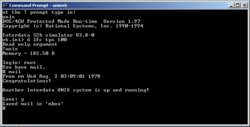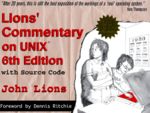UNIX Sixth Edition
| Unix V6 | |
 Logging into a V6 UNIX system | |
| Type: | Multi-tasking, multi-user |
|---|---|
| Creator: | AT&T/Western Electric |
| Architecture: | PDP-11 |
| Previous Version: | V5 |
| This Version: | V6 |
| Next Version: | V7 |
| Date Released: | May, 1975 |
UNIX Sixth Edition (often referred to as UNIX V6 or V6 UNIX - 'Unix' was still normally given in all capital letters at this point in time) was one of the most influential early versions of UNIX. It was the first version which was widely distributed outside Bell Labs, appearing as it did shortly after the influential CACM article on Unix, and it had an enormous impact.
It was also the base for many important branches of UNIX, including PWB/UNIX and the BSD Unix family (it was in fact the first version of Unix to have more than one descendant). It was also one of the more popular Research versions from Bell Labs, along with Unix Seventh Edition.
To many computer scientists encountering it for the first time in its era, it had the feel of a then mainframe operating system, but on a minicomputer; it felt totally unlike all the other minicomputer OS's at the time. Many also still consider it to have been the system with the highest ratio of power to size, ever.
As distributed from Bell Labs, it ran only on PDP-11s, although outside Bell Labs it was later ported to several other architectures (see below).
It was very similar to the earlier UNIX Fifth Edition; the main change was the support of so-called split I+D space, both in the kernel, and for user processes. It also supported the PDP-11/70 with more than 256 Kilobytes of main memory, and the resultant UNIBUS map.
UNIX V6 included even more documentation than V5, which included gems like Programming in C - A Tutorial.
Contents
Other Platforms
In addition to the PDP-11, which was the only machine the original Bell Laboratories distribution of V6 ran on, it was later ported to several other architectures.
Interdata 7/32 and 8/32
The first port of Unix to another architecture was performed outside of Bell Laboratories; V6 was ported to an Interdata 7/32 at the University of Wollongong. This was also the first port to a 32 bit platform, although Bell completed their own port to the very similar Interdata 8/32 shortly thereafter (that port later became Unix Seventh Edition).
Intel 80286
There is a port by Szigeti Szabolcs to the Intel 80286 CPU, available in the Unix Archive under Other/V6on286. It requires a copy of MS-DOS to run.
i386
There is a 32-bit re-write to the x86 cpu, an instructional operating system called 'xv6', used at MIT for an operating systems course.
Folk Lore
V6 Unix is also famous because of the "Lions book". John Lions at the University of New South Wales wrote up an excellent dissection of the UNIX kernel, and taught it in his OS classes.
Unfortunately, the book ran into intellectual property issues with Bell, so its formal distribution was halted; however, it became the guide to UNIX internals as it was photo-copied over and over, in a Western equivalent to the samizdat of the old USSR.
Recently, with the open release of older versions of UNIX, the intellectual property issues were cleared, and the Lions book is now finally publicly available.
Games
The game situation didn't improve that much from V5 to V6.
bj chess cubic moo ttt wump
Running UNIX V6
To install and run UNIX V6, one needs a distribution (either an image of a distribution tape, or images of disks), and either an emulator, or an actual PDP-11 or Interdata.
V6 can be run on a real PDP-11/23, but it takes a few minor mods to do so.
Distros
There are two different distribution sets (as disk images) for V6 in the TUHS archive: 'Dennis_v6' and 'Ken_Wellsch_v6' (below). The contents page says:
Dennis_v6 --------- v6root.gz, v6src.gz and v6doc.gz are a set of three RK05 images of Sixth Edition with root, /usr and documentation, from Dennis Ritchie. Ken_Wellsch_v6 -------------- v6.tape.gz is a copy of the Sixth Edition distribution tape which was sent in by Ken Wellsch.
It notes that there are differences between the two, but hadn't investigated what they are. Here are some details: the source files for the kernel are identical, except for sys/ken/main.c, which has the following added in the Wellsch version:
printf("RESTRICTED RIGHTS\n\n");
printf("Use, duplication or disclosure is subject to\n");
printf("restrictions stated in Contract with Western\n");
printf("Electric Company, Inc.\n");
(What clearly happened is that after they'd done some distribution, the AT+T lawyers made them add that.) Anyway, as a result, the binary system images 'rkunix', etc are slightly different between the two.
Everything else seems to be identical: everything in /bin, /etc, /lib, /usr/bin and /usr/lib are all identical.
SIMH
One possibility for an emulator is to use SIMH; you can get V6 by looking for uv6swre.zip and iu6swre.zip, PDP-11 and Interdata versions respectively.
There is also a great lecture series involving SIMH and v6 which can be found here.
Ersatz-11
Another choice for an emulator is Ersatz-11; complete instructions for how to bring up V6 under Ersatz-11 are available, as well as instructions for how to make a more usable V6 under Ersatz-11: see the link below.
See also
- UNIX file system
- UNIX V6 internals
- UNIX V6 kernel memory layout
- Installing UNIX Sixth Edition
- Installing UNIX v6 (PDP-11) on SIMH
- Installing UNIX Sixth Edition on Ersatz-11
Further reading
- Dennis M. Ritchie and Ken Thompson, The UNIX Time-Sharing System - the classic original CACM paper that ignited the spread outside Bell (PDF, but not a scan)
External links
- V6 - V6 distro at TUHS, as individual files
- Odd Comments and Strange Doings in Unix - "a small, shared treasure" from DMR
- UNIX Programmer's manual: Sixth Edition
- UNIX Program Description - V6 version, prepared by the UNIX Support Group; detailed description of the kernel
| v • d • e UNIX Versions, Vendors and Related |
|---|
| Research Unix PDP-7 UNIX • V1 • V2 • V3 • V4 • V5 • V6 • V7 • V8 • V9 • V10 • LSX • MINI-UNIX • Unix/32V
AT&T - CB-UNIX • PWB/UNIX • USG UNIX • System III • System IV • System V BSD - 2.9 BSD • 2.10 BSD • 2.11 BSD • 3BSD • 4BSD • 4.1 BSD • 4.2 BSD • 4.3 BSD • 4.4 BSD BSD Descendants 386BSD • NetBSD • FreeBSD • OpenBSD • NeXTSTEP • Darwin |
| Other - xv6 • AMIX • SunOS • Solaris • ULTRIX • A/UX • XENIX • AIX • Dell UNIX |
